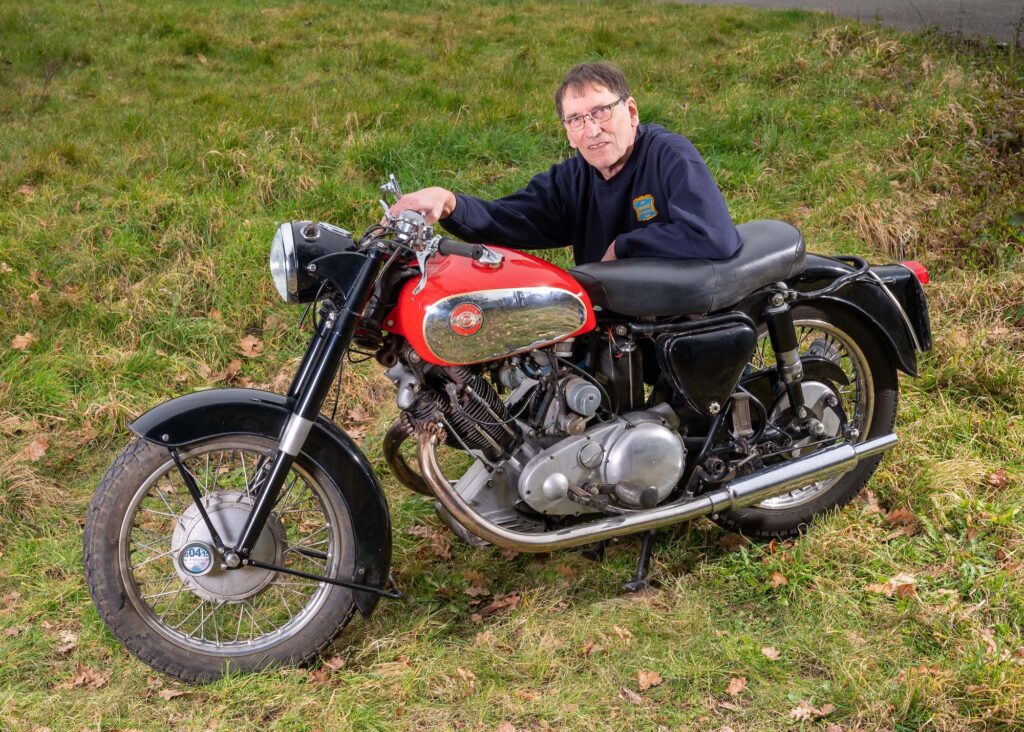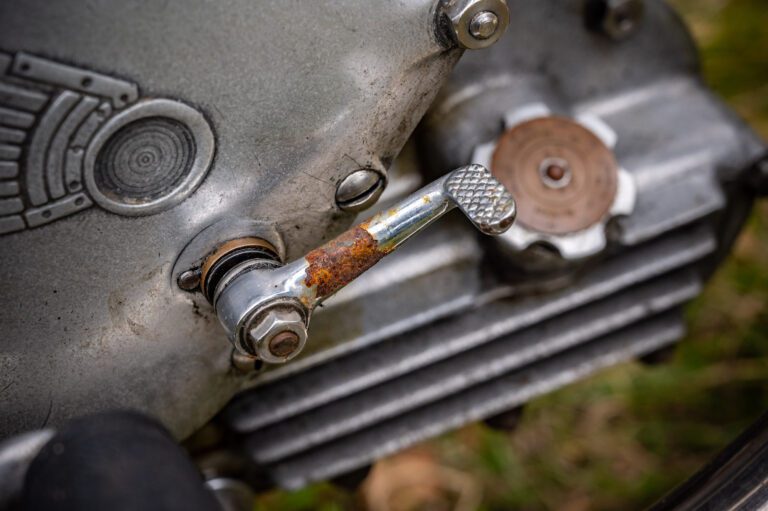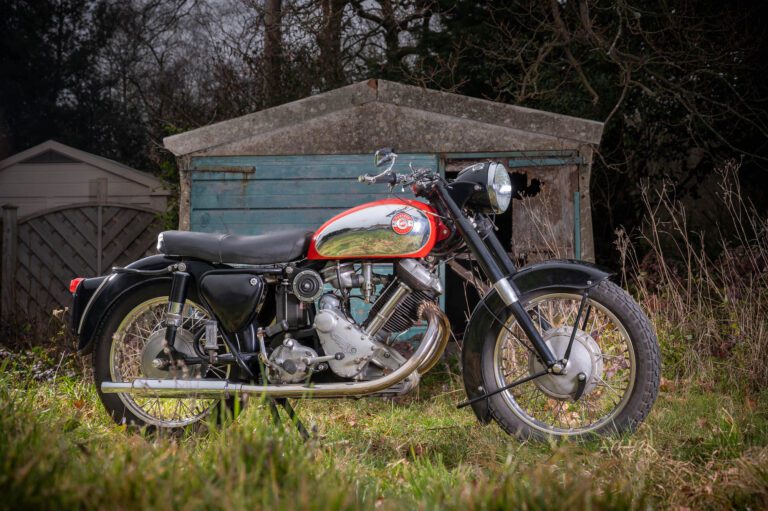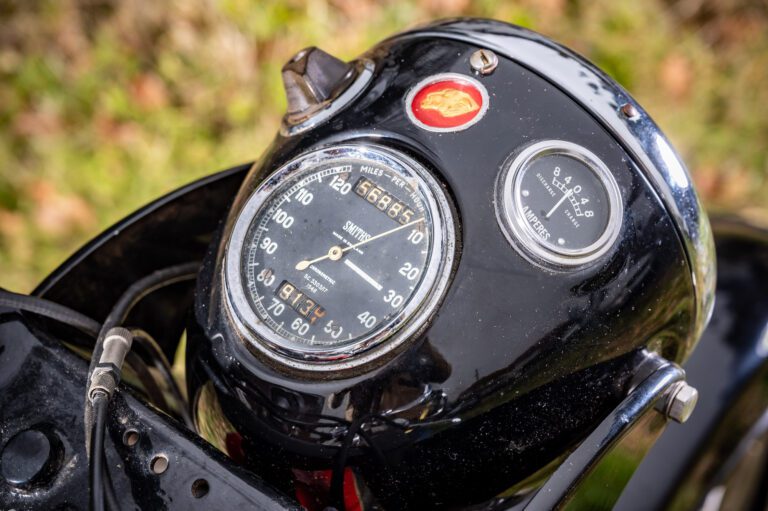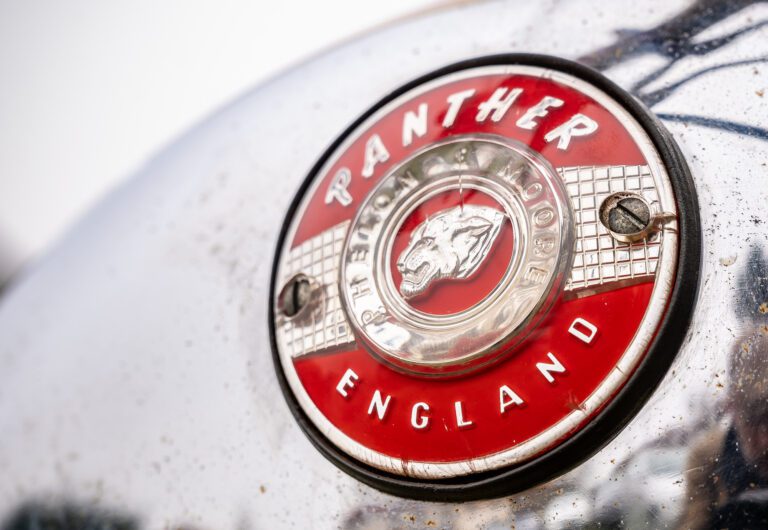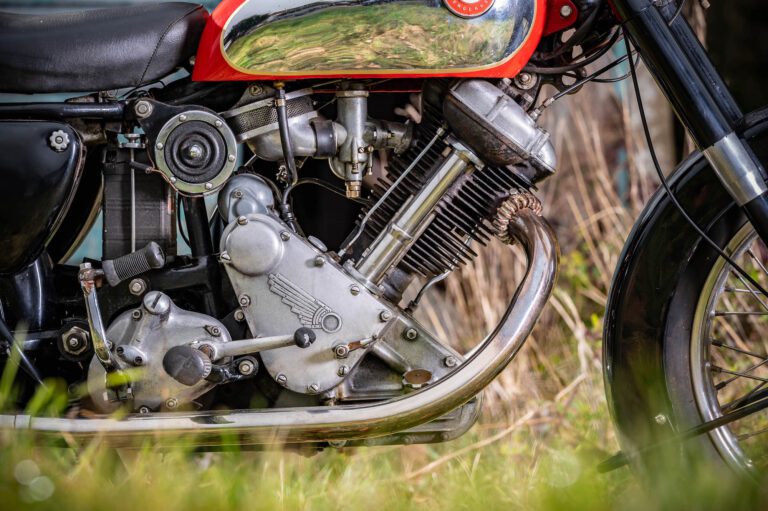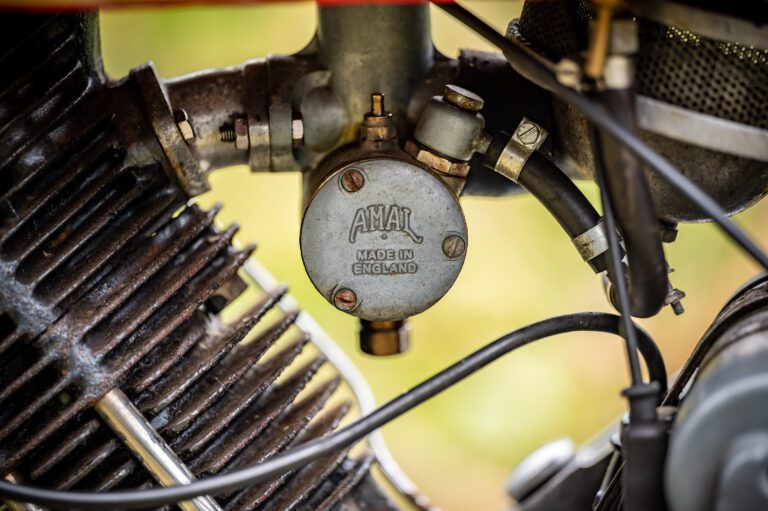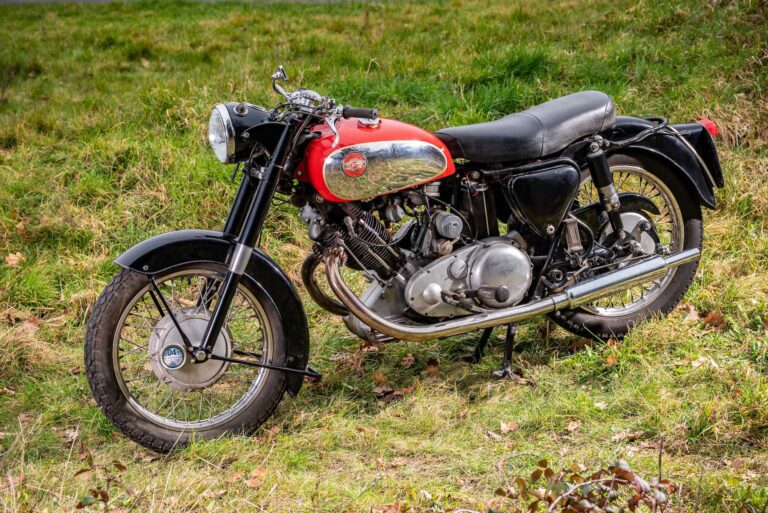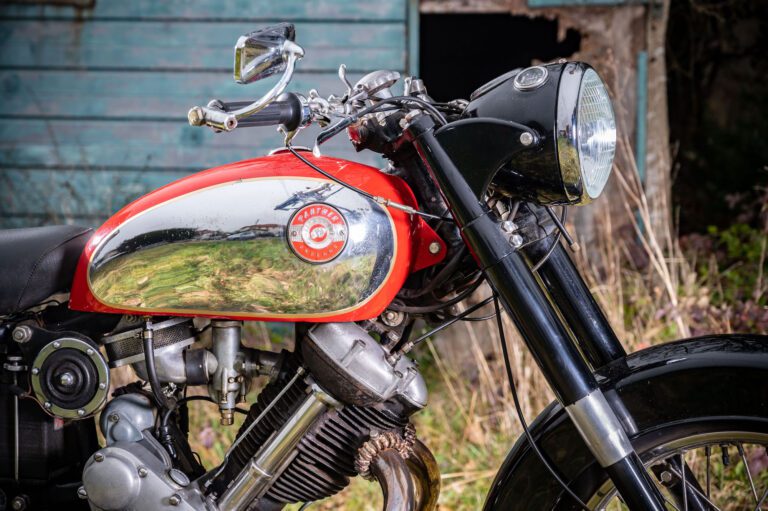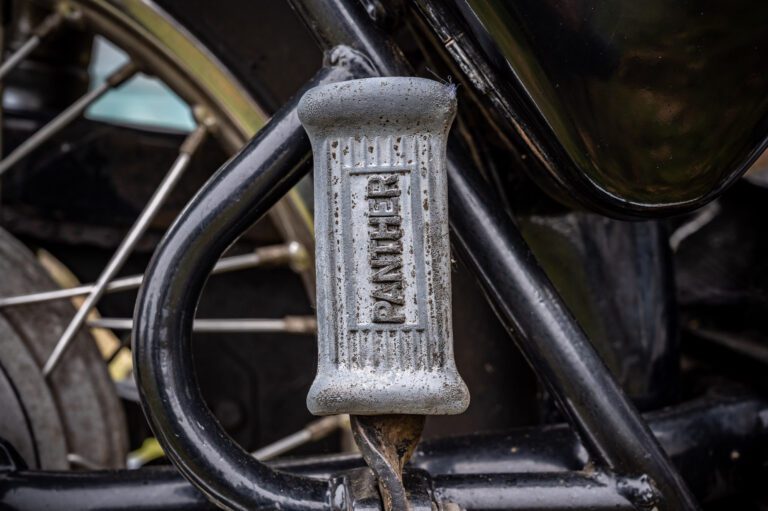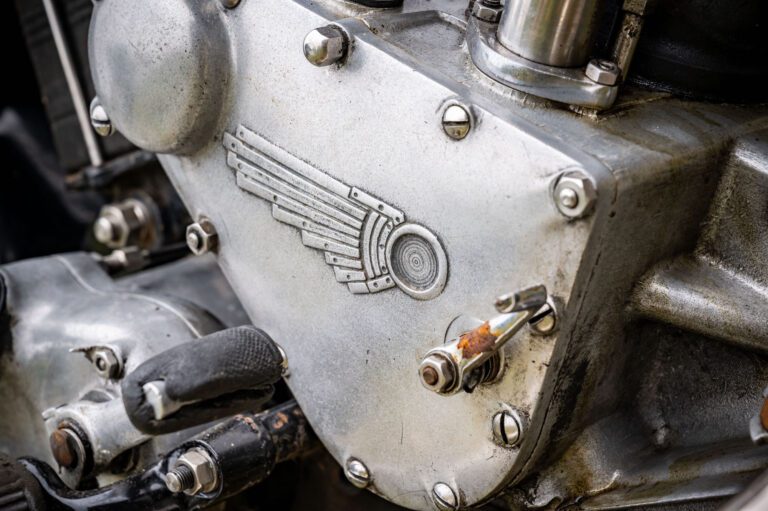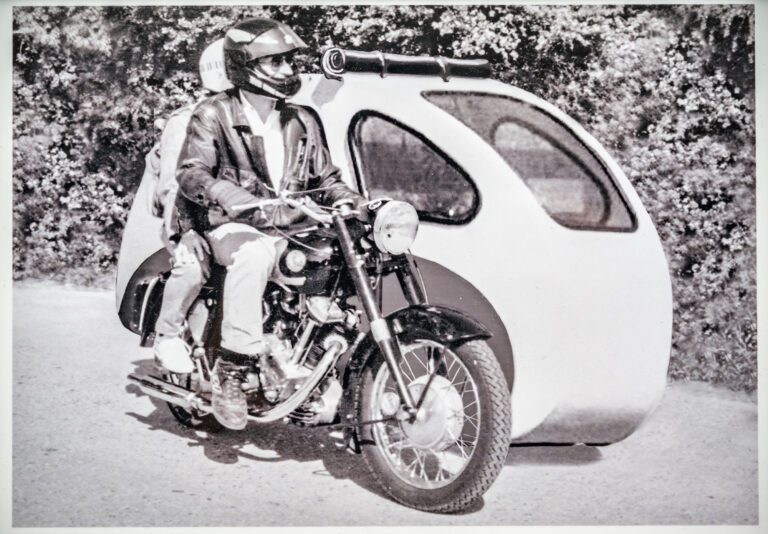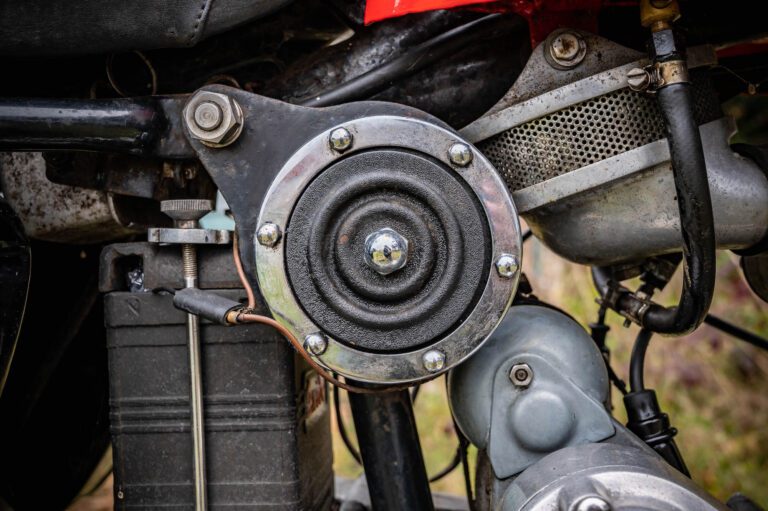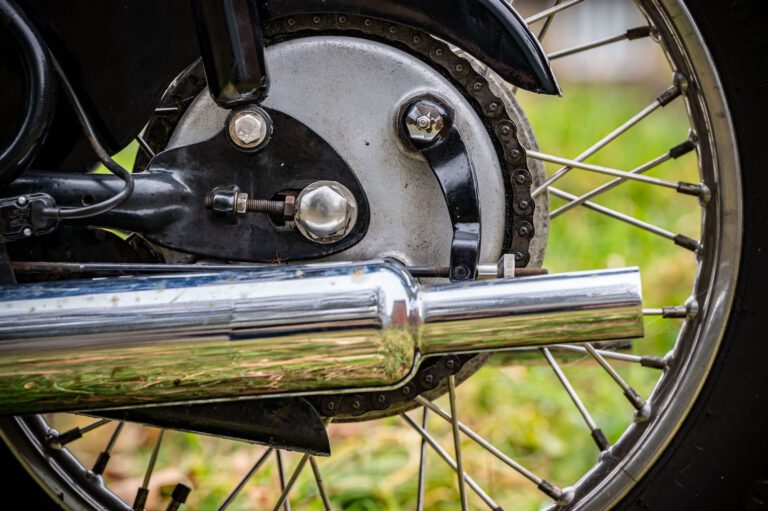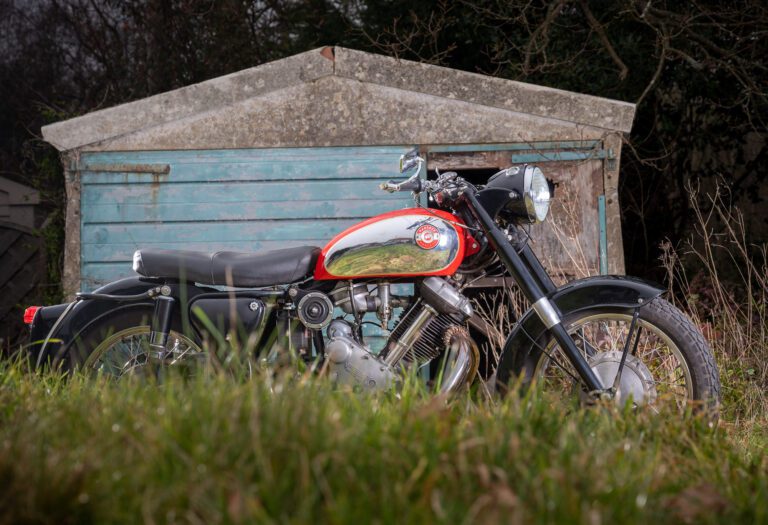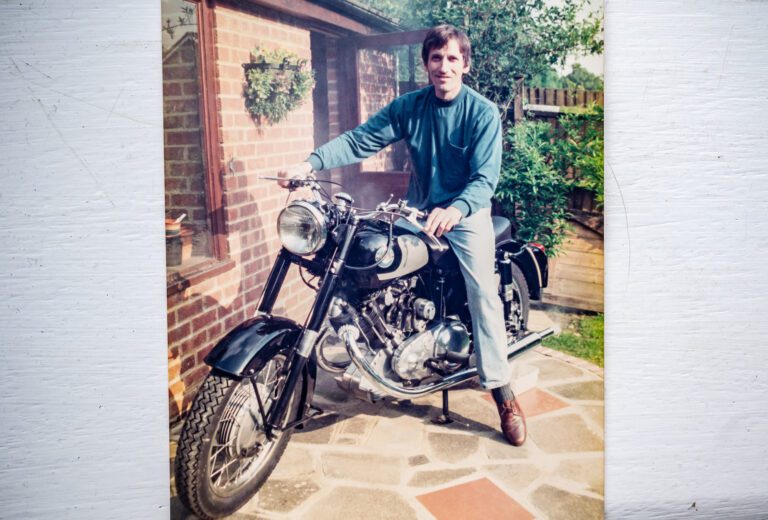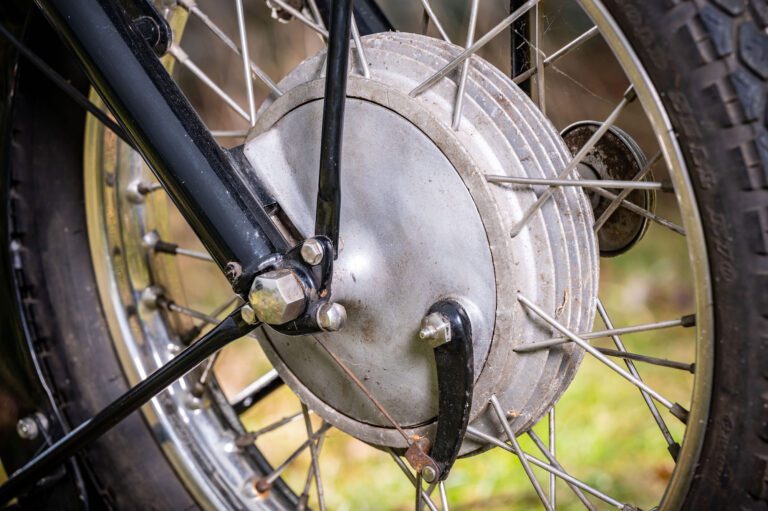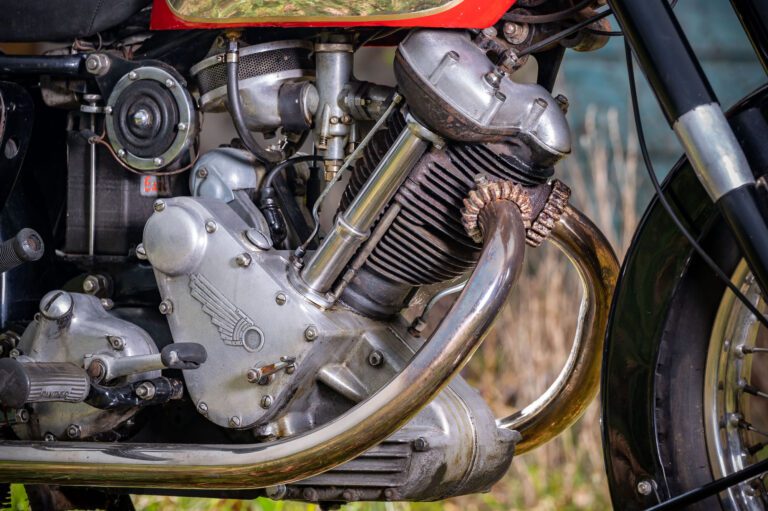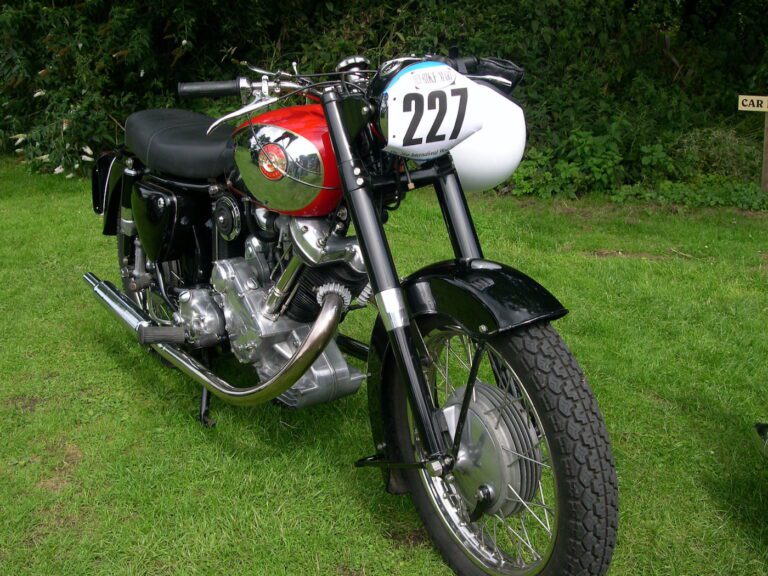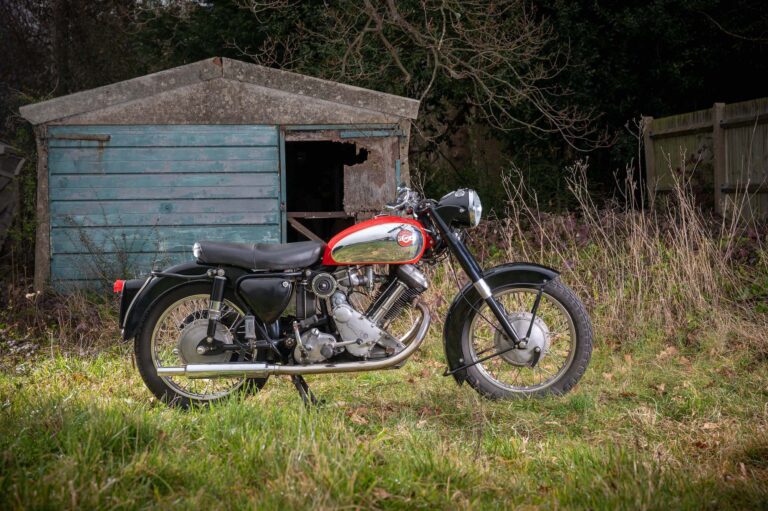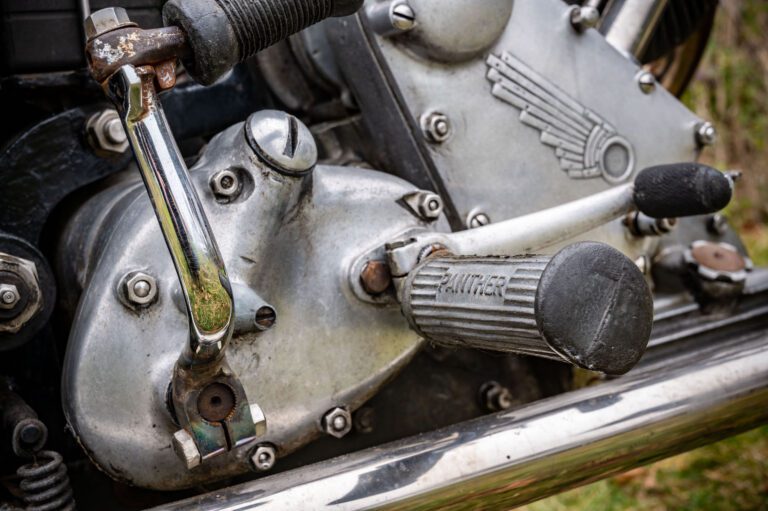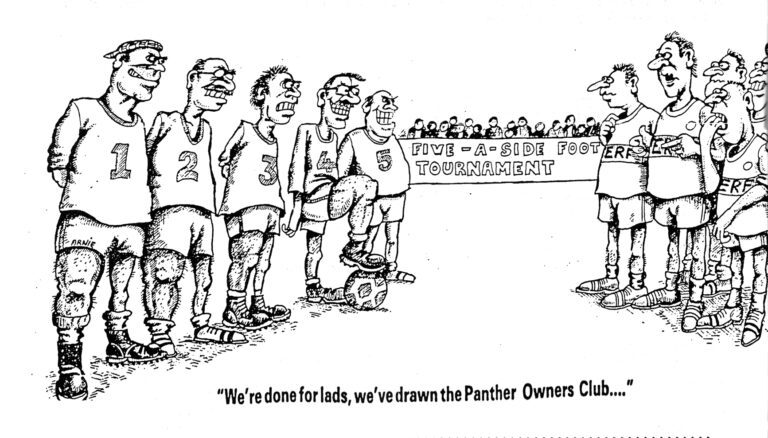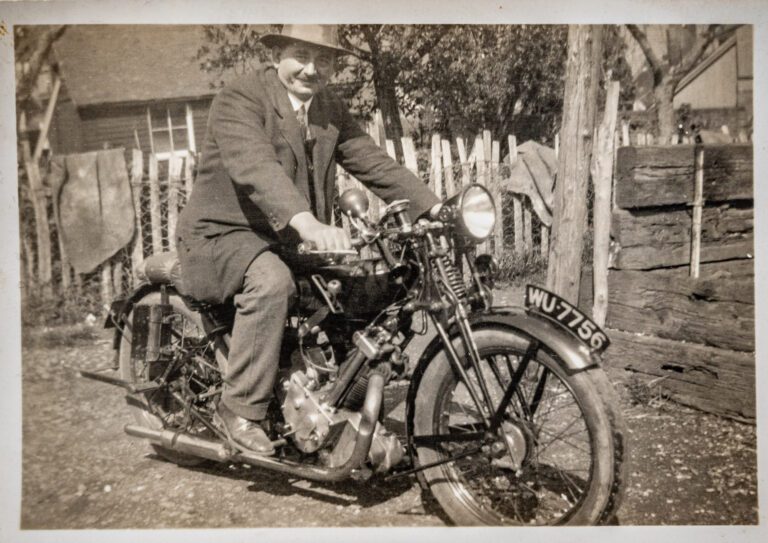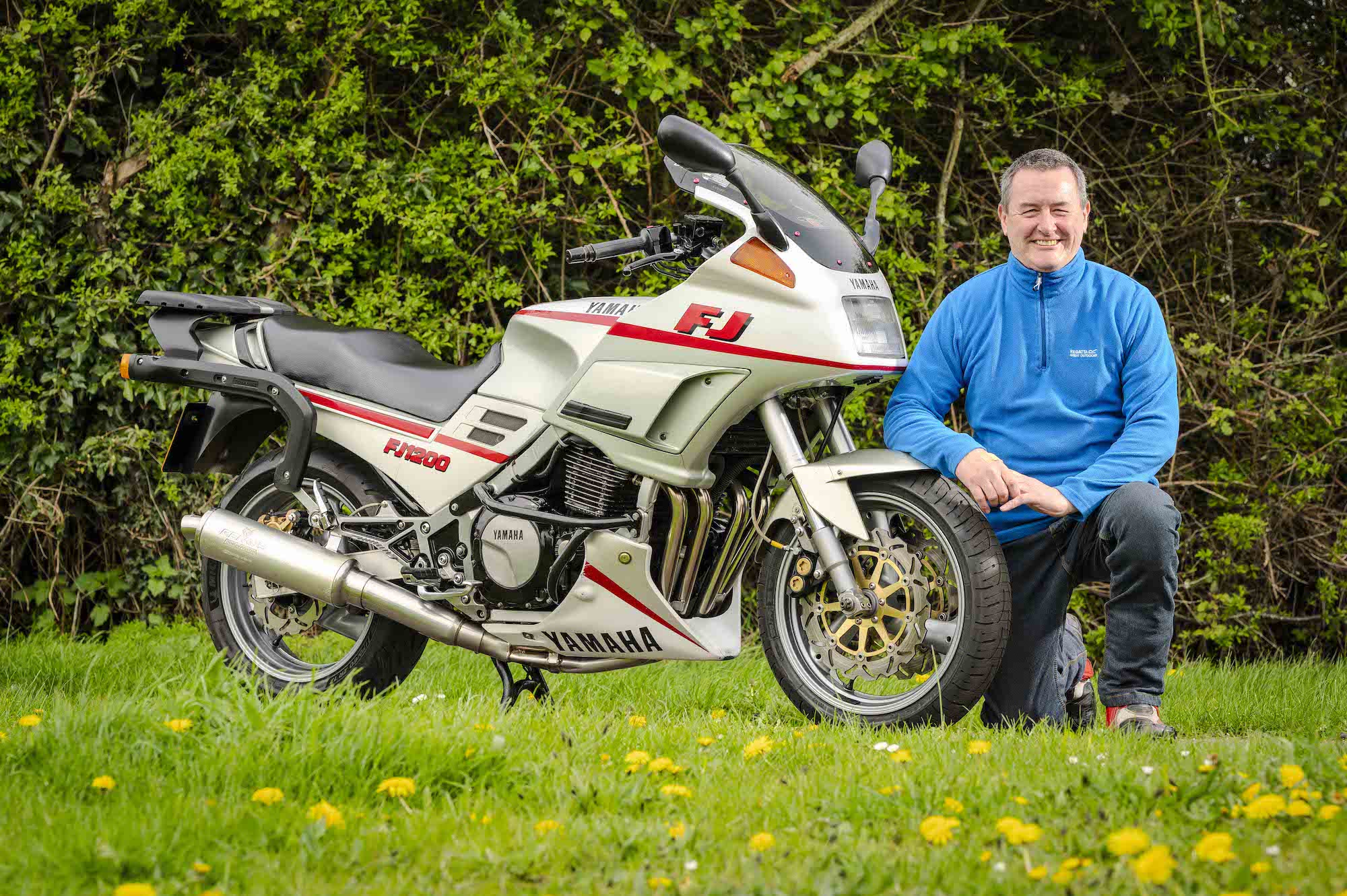It wasn’t the best of starts for the big Panther.
Noel Wills had just brought home this “rideable wreck” of a Model 120, with a rusty base for a seat, the wrong headlight and fuel tank, and a centre stand that had been partly sawn off.
“I leant it across the back door and I gave it an enormous whack to try to start it,” he laughs. “There was a huge bang when it backfired. I went through the glass kitchen door and my three-year-old son, who was standing on the other side of the door, got showered in glass.
“I didn’t realise it had a valve lifter and without lifting that up you can’t shift it.”
Restored Model 120 is still going
That was in 1968 and, despite such an inauspicious start, more than five decades on and Noel still has the heavy old bike with its famous big single sloper engine.
It’s clearly no longer a wreck, and sports the correct headlight, seat and petrol tank following various renovations, the last of which was completed in about 1998, “before its slow decline”.
“I’ll keep riding it for as long as I can,” says Noel, 77. “Why not? It takes me back to my youth, and it’s just a thrill to ride, and the sound of it…bom, bom, bom, bom.
“I was at a heavy horse show at Shoreham once, where there are always a lot of bikes, and I thought I heard a big single like mine. It turned out it was a 3-litre, single cylinder tractor, but it sounded just like my bike.
“In the past I have floated the idea of getting rid of it, but my kids have fond memories of it and they say ‘you can’t do that, we grew up with that, it’s part of the family’.
“It represents the story of my life – we’re both deteriorating slowly!”
Although Noel didn’t get his first bike, an NSU Quickly moped, until he was 20, he’d helped build one as a teenager in the Scouts in the late ‘50s.
“I was living in Croydon and the Scout hut was built on wasteland, and the surroundings were a bombsite with a huge air raid shelter and lots of concrete,” he remembers.
“No health and safety”
“One day we managed to acquire some bits and pieces of a motorbike – I think it was an Ariel Red Hunter frame and wheels, and we also got hold of a Panther engine, a 250cc I think. We cobbled this engine into the frame and used to roar around this bombsite. You were a bit freer in those days because there was no health and safety.”
After attending art college, Noel briefly got a job on a building site before working as a silkscreen printer.
When the firm he was working for moved from St James’s Street in London to Reigate, he found himself in need of transport for the 30-mile journey from his home in Petts Wood.
Enter the 50cc NSU Quickly, which was “absolutely wonderful”.
“People still extol their virtues even now,” he says. “Even people with an amazing collection of bikes say ‘I wish I still had my NSU Quickly’.
“It’s quite a hilly journey to Reigate and the only fault with it was that as you came to Sanderstead Hill where the road crosses the railway line the spark plug always fouled.
“It always happened in exactly the same spot, so I always carried another plug – just put it in and carry on.
“Until one day when it completely died on Sanderstead Hill. My father had to come and pick me up with it, and I think he took it straight to the dump.”
Next came a James Captain, by which point Noel was working as a window dresser at Chiesmans department store.
The bike had a “peculiar quirk”
“This bike had a peculiar quirk – every time I turned left I fell off,” he laughs. “It didn’t matter how fast or how slow you went, you still fell off, but you get used to things so I just put up with it.
“At some point I thought ‘I’ve got to do something about this’, so I completely stripped the bike down, but I couldn’t find anything at all.
“Then one day I was sent over to work at a store in Romford, and the bike was a bit jerky. I looked down behind me to see why and I noticed the chain was whipping, and I thought ‘something’s seriously wrong here’, but I had to carry on.
“I stripped it right down again and I found that the single tube frame had completely cracked in half immediately behind the centre stand bracket. It was so covered in crud I couldn’t see it before. So that had to go.”
Noel’s run of ill luck continued with an ex RAF AJS CSR14 250cc, which served him well for about two years until one fateful Sunday when he was working at Chiesmans store in Lewisham.
“I loved that bike,” he says. “I’d totally done it up, resprayed it, rechromed it, everything.
“On that Sunday I’d parked it round the back of the store, came out and thought ‘ah, I’m sure I parked it there, I must have parked it round the corner’, so I went round all the corners and it slowly dawned on me when I found my leggings on the dustbin at the back of the shop that somebody must have nicked it.
“I phoned the police, who said ‘we get 98 per cent of them back’, but obviously that was one of the 2 per cent.”
Having phoned the police, Noel walked across the road to the nearest bus stop, which was outside a newsagents with a board of adverts in the window.
“I noticed there was a 1960 Panther for sale and that chimed with me, and it was only £40,” he says. “I just needed something quickly to get to work. A friend of mine came over with me and laughed when he saw this heap.
“It was just diabolical”
“It’s difficult to describe – it was just diabolical. The whole thing had been painted black – I think it must have been Dulux, and it had clearly rained heavily at the time so it was all pitted.
“It had a square headlight, a peanut tank, someone had tried to chop it, the fork shrouds had disappeared so you could see the fork stanchions. The seat had no padding on it, it was just a rusty base, but it was just about rideable, and it had an MOT.
“I know I was robbed, but it was only £40…”
One immediate problem was that, at the time, Noel had yet to pass his bike test, and the big Panther was 650cc, way too powerful to ride on learner plates.
“I managed to acquire a Busmar double adult sidecar, because if you had a sidecar you were away,” he says. “I used it with the sidecar for years, and the kids grew up riding in it – that was our transport. Eventually I took it off and put it in the front garden where it acted as a kind of wendy house.”
Indeed, the Panther Model 120 was so popular with sidecar users that its Yorkshire-based manufacturer Phelon & Moore supplied them with sidecar gearing and sidecar fork-trail.
At one point the company estimated that 90 per cent of all bikes were destined for use with a sidecar.
Noel has a theory about how his bike ended up in such a mess.
“It had eight previous owners in eight years,” he says. “The thing with Panthers is that we’re on the doorstep of the infamous Johnson’s Cafe here, and people would occasionally dare to do the run down Death Hill to the roundabout and back before the jukebox record stopped.
“If you were on a Panther and it went bang, which they often did, you probably just threw it in a hedge and forgot about it. Probably, at some point, someone fished it out and thought ‘I’ll do something with that’ – and so on.”
After five years riding with the big sidecar, Noel passed his bike test and thought it was time to get a car, of sorts.
“Insane” Bond Sports 875
“Having a full motorcycle licence, you could drive a three wheeler, so that’s what I got,” he says. “I bought this car, and it was absolutely insane. It was a Bond Sports 875. I read a report on it in Motorcycle and Three Wheeler magazine, and they said they’d tested it and had it up to 125mph if you’ve got the nerve – wildly optimistic but still frightening!
“John Surtees broke a class lap record in one at 100mph at Brands, and mine would certainly do more than the manufacturers’ performance figures even with three adults on board – perhaps I had a faulty speedo?
“It had a Hillman Imp engine in the back and was built on the Imp chassis. You could see anything off from the traffic lights.”
Around this time, Noel got a job teaching art, his other passion alongside his bikes (he also has a 1943 ex army Indian 741), hanging his work in a gallery at Whiteleys department store where he had also worked.
With the Bond taking the strain, it was time to completely sort out the Panther.
“I stripped it down and took the frame to Crayford to be powder coated, plus a few bits of welding,” he says. “I got the right headlight and the right petrol tank. It took me quite a long time to build it up.
“The first ride without the sidecar was…interesting. It was due for its MOT, and I took it to Cray Motorcycles in Orpington, a nice chap who knew everything about motorcycles.
“His eyes always lit up when he saw my Panther come in, because as part of the MOT you had to take it out and go for a run round the block.
“But this time it was without the sidecar. Off he went, and he came back absolutely white as a sheet, because I hadn’t changed the tyres. It hadn’t occurred to me, but the tyres on it for the sidecar are flat, whereas for solo you need the rounded tyres. It was barely controllable, but I think he was just wimping out.”
Because he had the Bond, the Panther 120 became more of a leisure pursuit, and Noel joined the Panther Owners Club (POC) and the Vintage Motor Cycle Club (VMCC), with he and wife Dianne going on rallies all around the south coast of England.
Bruising experience
“It behaved itself apart from on one occasion, well a bit more than one occasion actually,” he smiles. “Dianne and I had a falling out because we were both getting badly injured on these rides.
“The rear suspension has Armstrong shocks and they’re pretty solid, so if I hit a pothole Diane would get bruised, and she’d punch me in the kidneys so I’d get bruised.
“One day in about 2000 we were on the west Kent run and we got not far from Rye when I got a puncture in the rear wheel, and I had to fix that. We did a few more miles and we got another one, did another 30 miles and we got another one, so I had to repair the tyre three times.
“Really, that was the end of it for Dianne – she’d had enough. There was some discussion and it was decided that what we needed was a different bike, one with better suspension.
“I thought about this, and we went and looked at things like Laverda Ghosts. In the end I went and bought an Indian which has only got one saddle, which sort of solved the problem.
“Over the years though, Dianne has been remarkably forgiving or resilient – I’ve rebuilt it in the kitchen, the spare bedroom, and in the dining room.”
He would sometimes ride the Panther to the various schools he taught in over a 30-year career in teaching.
“The students thought it was amazing, you got quite a bit of kudos,” he says. “When I got to Blackheath High School for girls, quite a lot of them were interested in it.
“But surprisingly, this colleague of mine, a classical scholar, was absolutely obsessed by it. He used to follow me to rallies to see it, but he never wanted to ride it.”
While most bikers Noel knows are buying and selling bikes all the time, he enjoys the Panther and the Indian and now has no desire to get anything else.
The Panther is like a “barely trained horse”
“Riding the Indian is like sitting in an armchair, but the Panther is something different,” he says. “It’s a very peculiar relationship you have to have with it. It’s like a barely trained horse – it has things it wants to do and to some extent you have to let it do it and go with it, and to another extent you have to wrestle it back into line. But I enjoy the challenge.
“Most bikers can tell you all the models of every bike that’s ever been built, but I’m not like that at all – I just enjoy riding them.
“When I ride the Panther now it’s still full of incident. Last year, I went down to a pub in Eynsford. I had bought new bulbs, but they were the wrong ones, so coming back through these country lanes in the dark, the headlight was probably overshadowed by the pilot light. I couldn’t see a thing.”
People often ask him, ‘why a Panther?’, this big old thumper that’s so notoriously hard to start that the Panther Owners Club has even been moved to put instructions on YouTube, and published the cartoon (pictured) of overdeveloped right legs.
“When I was clearing out my parents belongings, I came across a photograph of my Uncle George and he’s on a 1928 Panther wearing his auxiliary fireman’s brass helmet,” he says. “I didn’t realise there was a family history with Panthers at the time I bought it.”
Neither of Noel’s children, Lindsey and Lawrence (who was showered in glass), have followed in their father’s biker footsteps, so one day the bike will have to be sold.
“Being brought up with a Panther, it didn’t encourage them to want to ride,” he laughs, now looking forward to the spring and summer weather and returning to the VMCC and POC’s meetings and rides.
